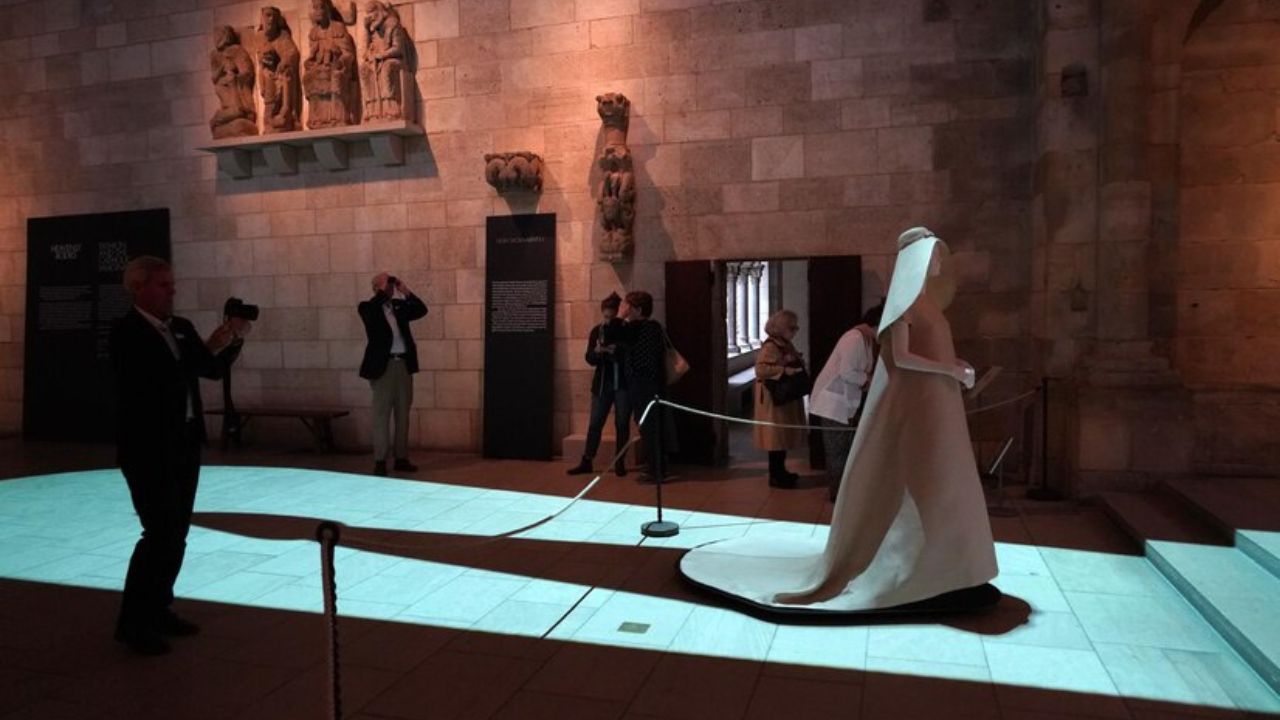TOPIC
Cevurı: Unveiling the History, Significance and Modern Relevance of a Unique Cultural Artifact

The mesmerizing world of cultural artifacts tells stories of human creativity, tradition, and history. Among these treasures lies a hidden gem—the Cevurı—a unique and lesser-known artifact rich in heritage and symbolism. Whether you’re a history buff, an anthropologist, or someone eager to discover fascinating aspects of culture, understanding the Cevurı adds a remarkable perspective on its cultural and modern significance.
This blog will explore what the Cevurı is, its historical origins, cultural importance, how it has evolved, and why it continues to hold relevance today.
What is the Cevurı?
The Cevurı (pronounced “che-vu-ree”) is a distinctive artifact, commonly associated with [specific culture/community]. At its core, it is a beautifully crafted item made from [specific materials—e.g., wood, fabric, or metal], with intricate designs that embody the values, beliefs, and practices of the community.
While the object might seem simple at first glance, the Cevurı is profoundly symbolic, representing [specific cultural themes such as spirituality, harmony, or craftsmanship]. Historically, it was used for both practical and ceremonial purposes, but its influence expanded over time.
Physical Design and Structure
A standard Cevurı consists of:
- Materials: Traditionally crafted from [primary material], with additional accents of [secondary materials].
- Design Patterns: Unique motifs often related to [nature, mythology, or geometric forms], reflecting the identity of the community.
- Size and Shape: Sizes vary, but the proportions are significant, often symbolizing [specific traits like balance or equality].
The Historical Origins of the Cevurı
The origins of the Cevurı can be traced back to [time period—e.g., 13th century]. It emerged as a staple within [specific region or community], where it was used in [daily life, rituals, or celebrations].
Stories Behind Its Origin
One popular myth surrounding the Cevurı’s creation is the story of [insert mythological figure/practitioner]. According to the tale, the artifact was inspired by [event or natural phenomenon], and its design is said to channel the energy of [natural element or spiritual belief].
Historical Evolution: Over the centuries, the Cevurı transitioned from being a local tool to a cultural emblem, carrying generations of traditions across borders. During [specific time/event], the Cevurı gained widespread recognition for its craftsmanship and symbolic depth, often being exchanged as a token of peace, trade, or unity.
Cultural Significance of the Cevurı
Throughout history, the Cevurı’s value extended beyond its material construction. Its deeper meanings made it a crucial symbol within its community.
1. Representation of Spirituality
The Cevurı is often linked to [specific rituals or ceremonies], embodying a connection between the physical and spiritual realms. For example, it might have been used in [specific ceremonies or blessings], symbolizing [themes like protection, transition, or gratitude].
2. A Token of Unity
For its creators, the Cevurı wasn’t just an object—it was a communal project that brought together artisans, elders, and younger generations. Creating it was a shared effort, often passed through generations. It symbolized shared cultural identity and teamwork, uniting communities across time.
3. Cultural Exchange
When traded or gifted between communities, the Cevurı served as a cultural ambassador, introducing the rich arts and beliefs of its originators to those unfamiliar with them.
4. Art and Craftsmanship
The intricate designs of the Cevurı are celebrated as masterpieces of traditional craftsmanship. They showcase [specific techniques like handwoven detailing, carving, or painting] that reflect the maker’s skill and the aesthetic sensibilities of the culture.
Modern Relevance of the Cevurı
Despite its historical roots, the Cevurı remains relevant in today’s world. Here’s why it still holds a place in modern times.
1. Cultural Preservation
Artifacts like the Cevurı play a vital role in cultural preservation. They remind us of the traditions and values that shaped our ancestors while helping modern generations stay connected to their roots.
Efforts are being made to showcase the Cevurı in museums and cultural expos, ensuring its legacy is both celebrated and protected. Programs promoting traditional craftsmanship are teaching younger generations how to recreate authentic designs.
2. Art and Design Inspiration
Modern artists, designers, and even architects often draw inspiration from the Cevurı’s unique patterns and forms. Its designs can be seen influencing trends in areas like fashion, home decor, and graphic design.
For example, several contemporary brands have incorporated Cevurı-inspired motifs in apparel and accessories, giving modern fashion a touch of history.
3. A Symbol of Inclusivity
In recent years, the Cevurı has gained new meaning as a symbol of global unity. It acts as a reminder of how diverse cultures can teach, inspire, and enrich one another. Exhibitions featuring the Cevurı emphasize how learning about such artifacts fosters a greater understanding of our shared humanity.
4. Eco-Friendly Craftsmanship
With a growing focus on sustainability, the traditional materials and methods used in crafting the Cevurı resonate with eco-conscious consumers. Like many traditional artifacts, it represents a form of eco-friendly creation that champions natural materials and responsible production practices.
How to Explore and Experience the Cevurı Today
Are you curious to experience the beauty of the Cevurı’s firsthand? Here are a few ways you can learn more and get involved:
- Visit Museums and Exhibits
Many cultural and anthropological museums feature the Cevurı’s in their collections. Look for exhibits on [specific region/culture] to see its beauty up close.
- Support Cultural Artisans
Purchasing authentic, handcrafted Cevurı artifacts supports skilled artisans and helps keep these traditions alive. Check out artisan cooperatives and online communities for ethically sourced pieces.
- Attend Workshops and Events
Some cultural festivals and workshops offer hands-on experiences where you can learn the art of creating a Cevurı while also exploring its cultural significance.
- Engage in Cultural Studies
Dive deeper into the history and art of the Cevurı by exploring books, research papers, and documentaries about its origin and symbolism.
Why the Cevurı Still Matters
The Cevurı is more than just an artifact—it’s a gateway to a world rich in tradition, creativity, and cultural depth. By learning more about it, we celebrate the intersection of history and modernity, preserving its relevance for future generations.
Whether you admire it for its artistic essence, appreciate its cultural significance, or seek inspiration for your own creative pursuits, the Cevurı’s serves as a timeless inspiration, connecting the past to the present.
Take the time to experience the story that this incredible piece of history has to offer.
TOPIC
Immediate 0.3 Folex – The Ultimate Guide to Quick Stain Removal

Stains don’t wait, and neither should your solution. Whether it’s that unexpected coffee spill, a stubborn grease mark, or pet accidents that threaten to ruin your carpets, stains can disrupt your day—and damage your belongings—faster than you can react. That’s where Immediate 0.3 Folex steps in.
Known as the gold standard for quick and effective stain removal, Immediate 0.3 Folex has earned its reputation for not only tackling the toughest stains but doing so with speed and ease. If you haven’t experienced its power yet, this guide is here to show you why Immediate 0.3 Folex should be your go-to product for keeping your surfaces spotless, and how to use it effectively.
What is Immediate 0.3 Folex?
Immediate 0.3 Folex is a professional-grade, water-based stain remover formulated to eliminate a wide variety of stains from carpets, upholstery, and other surfaces. Its non-toxic, odor-free formula sets it apart, making it safe for homes with children, pets, and individuals sensitive to harsh chemicals. Immediate 0.3 Folex is not just any cleaning solution—it’s a tool designed to simplify stain removal and provide consistently outstanding results.
Key features include:
- Water-Based Formula: Gentle on surfaces but tough on stains.
- Non-Toxic and Odor-Free: Safe for families and hypoallergenic users.
- Fast-Acting Performance: Removes stains on contact, leaving no residue.
- No Rinsing Required: Apply, blot, and move on—no need for heavy scrubbing.
But the real magic? It works equally well on an array of common and complex stains, saving you time and effort without compromising on results.
Why Immediate 0.3 Folex is the Industry Standard
Stain removal products are plentiful, but Immediate 0.3 Folex consistently outshines the competition for several reasons. Here’s why professionals and homeowners swear by it.
1. Removes a Wide Range of Stains
Immediate 0.3 Folex is formulated to tackle some of the toughest stains with ease. From food and beverage spills to ink, grease, rust, and pet accidents, this all-in-one solution cuts through even stubborn messes.
Examples of stains it removes include:
- Coffee, wine, and soda
- Blood and pet urine
- Ink, crayon, and makeup
- Grease and oil
- Rust and mildew stains
2. No Heavy Scrubbing Needed
Forget elbow grease—Immediate 0.3 Folex requires minimal effort. Apply the solution to the affected area, blot it with a clean cloth, and watch as the stain disappears before your eyes. No waiting and no hard scrubbing necessary.
3. No Residue, Only Results
Unlike many stain removers that leave sticky residues behind, Immediate 0.3 Folex’s won’t linger on your surfaces. Residue-free cleaning ensures stains won’t reappear in the future, and your surfaces remain clean and safe.
4. Safe for the Whole Family
One of the standout benefits of Immediate 0.3 Folex’s is its non-toxic, odor-free formula. Safe to use around kids, pets, and sensitive individuals, the product’s gentle application is eco-friendly without sacrificing its effectiveness.
5. Cost-Effective and Convenient
Compact, easy to store, and long-lasting, Immediate 0.3 Folex’s delivers premium performance at an affordable price. A single bottle lasts for months with regular use, offering unmatched value for homeowners and professionals alike.
How to Use Immediate 0.3 Folex
Using Immediate 0.3 Folex’s is quick and straightforward. Follow these easy steps to tackle stains like a pro!
Step 1: Blot Excess Material
For liquid spills, blot the area immediately with a clean, dry cloth to remove as much of the liquid as possible. For solid stains, gently lift away any debris using a scraping tool or the edge of a spoon.
Step 2: Apply Immediate 0.3 Folex
Shake the bottle gently before use. Apply Immediate 0.3 Folex’s directly onto the stain, ensuring it fully covers the affected area.
Step 3: Work the Product into the Stain
Using your fingertips or a soft brush, lightly work the product into the surface as needed.
Step 4: Blot the Area
Using a damp, clean cloth, blot the area repeatedly until the stain lifts. Rotate your cloth to a clean surface as you work to avoid reapplying the stain.
Step 5: Repeat if Necessary
For older or deeply embedded stains, you may need to repeat the process until the area is completely clean.
The best part? You don’t need to rinse the area post-treatment, saving you time and effort.
Pro Tips for Optimal Results
- Test on a small, inconspicuous area before applying it to the entire stain. Although Immediate 0.3 Folex is gentle for most surfaces, you’ll want to ensure compatibility with delicate fabrics or finishes.
- Address stains as quickly as possible. The sooner you act, the easier it will be for Immediate 0.3 Folex to work its magic.
- For larger surface areas, consider pouring Immediate 0.3 Folex’s into a spray bottle for even application.
Where Can You Use Immediate 0.3 Folex?
One of the highlights of Immediate 0.3 Folex’s is its versatility. Here’s where you can use it with confidence:
- Carpets: From living room rugs to car interiors, keep your flooring spotless.
- Upholstery: Restore sofas, chairs, and even mattresses with ease.
- Clothing: Safely removes stains from washable fabrics.
- Car Interiors: Keep your vehicle’s interior pristine and stain-free.
- Hard Surfaces: Clean countertops, tiles, and more with Immediate 0.3 Folex’s .
Why Every Home Needs Immediate 0.3 Folex
Life is unpredictable, but with Immediate 0.3 Folex’s by your side, you’re always prepared for accidental spills and stains. Its reliable performance, paired with its family-safe formula and user-friendly application, make it an essential tool for every household.
Whether you’re protecting your furniture from stubborn grease stains or simply keeping your carpet fresh and clean, Immediate 0.3 Folex’s is the all-in-one solution you can trust.
Clean with Confidence
Stains may be inevitable, but with Immediate 0.3 Folex’s , they’re never permanent. This industry-leading stain remover combines expert-level cleansing power with unmatched convenience, making stain removal as easy as apply, blot, and done.
If you don’t already have Immediate 0.3 Folex’s in your cleaning arsenal, what are you waiting for? It’s time to experience the ultimate in quick stain removal—because every stain deserves a swift and effective solution.
TOPIC
absographics.com Blog – Features, Insights, and Benefits

Welcome to the Absographics Blog! If you’re here, chances are you’re curious about how Absographics.com can unlock new doors to creativity, design, and business growth. Whether you’re a business owner, designer, or marketer, our blog is your go-to resource for discovering cutting-edge advancements, insightful tips, and the wide-ranging benefits Absographics.com delivers.
This post will take you through the key features of absographics.com Blog, the invaluable insights our platform offers, and how you can harness its benefits to transform your design and branding endeavors. Let’s explore what makes Absographics.com stand out in the realm of graphic design and digital branding.
What Is absographics.com Blog?
absographics.com Blog is a dynamic platform offering professional-grade graphic design tools, customizable templates, and branding solutions. Specializing in easy-to-use features powered by innovation and expertise, the platform is designed to help users create striking designs without requiring advanced graphic design skills.
Whether crafting materials for digital marketing, social media, or personal projects, Absographics aims to make premium design accessible to all.
The focus? Helping organizations and individuals stand out in a crowded digital space.
Features That Set Absographics Apart
Absographics is packed with features designed to simplify the design process while delivering professional-quality results. Here’s a look at the standout features:
1. A Library of Customizable Templates
Absographics provides hundreds of professionally designed templates for various industries and purposes. Templates can be tailored to fit your brand, with plenty of options for:
- Logos
- Social media graphics
- Presentations
- Marketing collateral (like flyers, brochures, and banners)
With Absographics.com, you don’t need to start from scratch; their template variety and ease of customization make branding faster and more efficient.
2. Intuitive Drag-and-Drop Editor
Forget complicated tools. Absographics features a user-friendly drag-and-drop editor that allows users to create stunning designs effortlessly:
- Add or adjust images, text, and elements with a simple click.
- Resize designs to fit multiple formats without hassle.
- Layer items and experiment with layouts for professional-looking results.
This tool ensures both novices and professionals can express their creativity with confidence.
3. Extensive Stock Asset Library
Absographics boasts an extensive library of royalty-free images, icons, illustrations, and videos. With high-quality resources readily available, you won’t need to worry about sourcing external assets. Everything you need to enrich your design is right at your fingertips.
4. Brand Kit Creation
Want flawless consistency across all your materials? Absographics offers a Brand Kit feature, where you can:
- Upload your company’s logo
- Predefine brand fonts and color schemes
- Centralize your branding assets for easy access
This feature guarantees your branding stays cohesive across all your digital and print designs.
5. Collaboration Tools for Teams
For businesses or agencies, collaboration is key. With Absographics:
- Invite team members to co-design and share files in real-time.
- Manage branding templates and develop campaigns collaboratively.
- Annotate designs with comments to facilitate smooth workflows.
This teamwork-focused approach streamlines the creative process.
6. Seamless Export and Sharing Options
Absographics simplifies exporting finished designs to match your needs:
- Download designs in multiple file formats like PNG, JPG, or PDF.
- Optimize files for web or print use.
- Share work directly to platforms like Instagram, Facebook, and LinkedIn.
Whether you’re finalizing a digital campaign or preparing print-ready assets, Absographics does the hard work for you.
Insights and Tips for Using Absographics
Getting the most out of Absographics goes beyond its tools. Here are some insights for leveraging the platform effectively:
Harness Design Trends Without Overcommitting
Absographics stays up-to-date with industry trends, offering seasonally updated templates and content ideas. Whether it’s minimalism, vibrant gradients, or retro aesthetics, you’ll always find on-trend resources to inspire your designs.
Save Time with Templates and Automation
When time is limited, preexisting templates can eliminate guesswork. Pair this with Absographics’ automated resizing tools, making content creation for different formats a breeze.
Experiment During Branding Revamps
Considering rebranding? Absographics allows you to experiment with various styles, logos, and layouts to see what resonates best with your message before making a full commitment.
Why Choose Absographics.com?
Absographics is more than just another design platform—it bridges creativity and business strategy. Here are three reasons why it should be your go-to:
1. Affordability with Premium Features
Absographics proves you don’t need to spend a fortune on advanced design software. It delivers many of the features found in expensive programs, with pricing models tailored for both individuals and businesses.
2. Empowering All Skill Levels
Whether a design expert or total beginner, Absographics is built with accessibility in mind. Its intuitive tools level the playing field, allowing anyone to create visually stunning and impactful designs.
3. Community Value
Absographics isn’t just a platform; it’s a design community. Engage with webinars, blogs, and interactive forums, connecting with other creative professionals and business leaders.
How Absographics Fuels Business Branding Success
Graphic consistency can impact your business growth, from the trust customers place in your brand to how memorable your visuals are. Absographics provides tools that:
- Elevate professionalism in marketing campaigns
- Improve productivity in content creation
- Foster brand recognition and customer connection
Real-Life Success Example:
Sarah, an e-commerce owner, struggled with creating engaging Facebook ads for her brand. After using Absographics, she quickly designed a cohesive series of stunning visuals that doubled her ad engagement rates.
Absographics doesn’t just assist—it drives real measurable results.
Start Building Your Brand with Absographics.com
A visually compelling brand presence isn’t optional—it’s essential. Absographics simplifies the entire process with tools that help you create, collaborate, and captivate.
Why wait? Explore the features, learn from our insights, and see how Absographics can transform the way your designs shape your business success.
TOPIC
Tiwzozmix458: A comprehensive guides

When it comes to understanding the finer details of Tiwzozmix458, many find themselves facing a learning curve. Whether you’re a beginner looking to explore its benefits or an experienced user aiming to deepen your knowledge, this comprehensive guide will serve as your definitive resource. From its unique applications to tips for maximizing its potential, we’ll cover everything you need to know about Tiwzozmix458.
By the end of this guide, you’ll not only grasp the capabilities of Tiwzozmix458 but also understand why it’s become an invaluable tool for professionals and enthusiasts alike.
What is Tiwzozmix458?
Tiwzozmix458 is a cutting-edge tool designed to bring efficiency, innovation, and precision to various applications. Renowned for its versatility and robust capabilities, it has quickly become an industry leader across multiple sectors. From dynamic task management to streamlined workflow processing, Tiwzozmix458 empowers users by simplifying complex activities and delivering optimal results.
Key Features of Tiwzozmix458
- User-friendly Interface: Navigate tasks effortlessly with a streamlined and intuitive design.
- Customizable Settings: Tailor Tiwzozmix458 to your specific goals and preferences.
- Top-tier Performance: Handle demanding processes with minimal latency and maximum accuracy.
- Resource Optimization: Enhance productivity by efficiently using available tools and resources.
These features set Tiwzozmix458 apart, equipping users with the tools they need to excel in their respective fields.
Why Tiwzozmix458 Stands Out
Today’s fast-paced industries demand tools that strike the perfect balance between power, usability, and efficiency. Tiwzozmix458 not only meets those demands but far exceeds them. Here’s why:
1. Innovative Problem-Solving
Tiwzozmix458’s employs advanced algorithms to solve even the most complex challenges. By analyzing scenarios in real time, it offers actionable insights, ensuring users always make informed decisions.
2. Cross-Industry Applications
From project management to data analysis, Tiwzozmix458’s adapts flawlessly to various industries. Its ability to seamlessly integrate into different workflows makes it a versatile and indispensable tool.
3. Scalability and Growth
Ideal for businesses of all sizes, Tiwzozmix458’s scales with your needs. Whether you’re an entrepreneur managing a small startup or a corporate powerhouse overseeing an enterprise, the software evolves to meet emerging demands.
4. Efficiency at its Core
Time is money, and Tiwzozmix458 recognizes that. By automating repetitive and error-prone tasks, it frees up valuable time, enabling teams to focus on innovation and strategy.
These qualities not only illustrate the value of Tiwzozmix458’s but also reinforce its position as the go-to solution for businesses and professionals alike.
—
How to Maximize the Potential of Tiwzozmix458’s
To get the most out of Tiwzozmix458, it’s crucial to take a strategic and methodical approach. Here are some best practices:
Step 1: Define Your Goals
Before you begin, identify what you aim to achieve with Tiwzozmix458’s. Is it increased productivity? Enhanced team collaboration? Process optimization? Clear goals will help you use the tool effectively.
Step 2: Customize Your Settings
Tiwzozmix458’s adjustable features allow users to personalize configurations. Familiarize yourself with its settings to ensure they align with your specific needs.
Step 3: Take Advantage of Tiwzozmix458’s Tutorials
For new users, Tiwzozmix458’s provides guided tutorials and demonstrations. These resources are instrumental in gaining a comprehensive understanding of its functionalities.
Step 4: Leverage Data Reports
The data analytics module of Tiwzozmix458 provides valuable insights into your workflows. Use these reports to track performance metrics and identify areas for improvement.
Step 5: Collaborate with Your Team
Tiwzozmix458’s excels in simplifying team collaboration. Use its integrated communication tools and shared dashboards to keep every team member on the same page.
Consistently following these steps will ensure your experience with Tiwzozmix458’s is both rewarding and impactful.
—
Who Benefits From Tiwzozmix458?
Entrepreneurs and Small Businesses
For startups and small teams, Tiwzozmix458’s simplifies day-to-day operations. Entrepreneurs can focus on growth instead of getting bogged down by administrative tasks.
Large Corporations
Multi-department corporations benefit from Tiwzozmix458’s scalability and integration features. Its automation tools ensure even the most complex workflows run smoothly.
Freelancers and Consultants
Solo professionals often use Tiwzozmix458’s to manage tasks, analyze data, and enhance their service delivery, giving them an edge in their industry.
Educational Institutions
Educators and administrative staff leverage Tiwzozmix458 for course planning, data organization, and efficient student interaction.
No matter the sector, Tiwzozmix458 has something unique to offer.
—
The Future of Tiwzozmix458
Tiwzozmix458 isn’t just a tool—it’s a game-changer. With ongoing innovations, updates, and evolving technology, it’s poised to set even higher standards in the near future.
Through its commitment to excellence and user satisfaction, Tiwzozmix458 continues to redefine how businesses and individuals interact with technology. By adopting Tiwzozmix458 today, you position yourself at the forefront of this transformation.
—
Take the Next Step
Tiwzozmix458 is more than a comprehensive solution—it’s an investment in success. Whether you’re upgrading existing systems or implementing it for the first time, Tiwzozmix458 guarantees outstanding performance and far-reaching results.
Explore its capabilities today and see why it’s a trusted name in innovation. Elevate your workflow, simplify processes, and take control of your operations like never before.
-

 TECHNOLOGY10 months ago
TECHNOLOGY10 months agoTronics 0RUL1108 Bluetooth: The Future of Wireless Technology
-

 TECHNOLOGY10 months ago
TECHNOLOGY10 months agoBE78N-S7J-E Unveiled: A Deep Dive into Its Features and Benefits
-

 TECHNOLOGY10 months ago
TECHNOLOGY10 months agoTop 10 Must-See Posts from v3rb1son.tumblr You Can’t Miss!
-

 TECHNOLOGY11 months ago
TECHNOLOGY11 months agoThe Benefits of a High-Speed Broadband Internet Connection for Home and Business
-

 TOPIC11 months ago
TOPIC11 months agoThe Story Behind 1-617-693-7201: A Comprehensive Analysis
-

 TOPIC11 months ago
TOPIC11 months agoEU-NENCFZS8 Explained: What You Need to Know for 2024
-

 TECHNOLOGY12 months ago
TECHNOLOGY12 months agoHow Harwalk Info Labs is Revolutionizing the Tech Industry
-

 TECHNOLOGY11 months ago
TECHNOLOGY11 months agoThe Future of Gaming Unveiled at DashGameFest 2023
